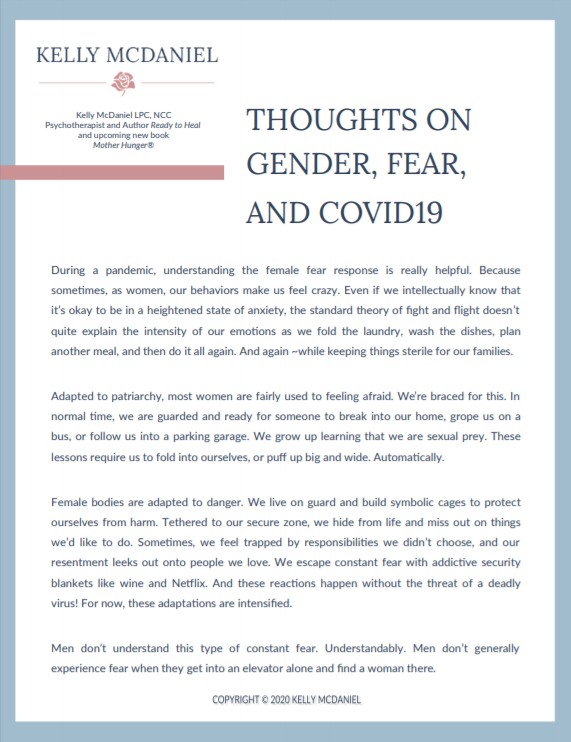 During a pandemic, understanding the female fear response is really helpful. Because sometimes, as women, our behaviors make us feel crazy. Even if we intellectually know that it’s okay to be in a heightened state of anxiety, the standard theory of fight and flight doesn’t quite explain the intensity of our emotions as we fold the laundry, wash the dishes, plan another meal, and then do it all again. And again ~while keeping things sterile for our families.
During a pandemic, understanding the female fear response is really helpful. Because sometimes, as women, our behaviors make us feel crazy. Even if we intellectually know that it’s okay to be in a heightened state of anxiety, the standard theory of fight and flight doesn’t quite explain the intensity of our emotions as we fold the laundry, wash the dishes, plan another meal, and then do it all again. And again ~while keeping things sterile for our families.
Adapted to patriarchy, most women are fairly used to feeling afraid. We’re braced for this. In normal time, we are guarded and ready for someone to break into our home, grope us on a bus, or follow us into a parking garage. We grow up learning that we are sexual prey. These lessons require us to fold into ourselves, or puff up big and wide. Automatically.
Female bodies are adapted to danger. We live on guard and build symbolic cages to protect ourselves from harm. Tethered to our secure zone, we hide from life and miss out on things we’d like to do. Sometimes, we feel trapped by responsibilities we didn’t choose, and our resentment leaks out onto people we love. We escape constant fear with addictive security blankets like wine and Netflix. And these reactions happen without the threat of a deadly virus! For now, these adaptations are intensified.
Men don’t understand this type of constant fear. Understandably. Men don’t generally experience fear when they get into an elevator alone and find a woman there.
According to Dr. Shelly Taylor, women respond differently to danger than men do. In her groundbreaking work, now widely known as the tend and befriend theory, Taylor found that women demonstrate affiliative, pro-social behavior in response to a threat. In response to stress, women tend (groom, feed, stroke, clean) and befriend (gather, connect). While women can “fight and flight” just as much as men do, Taylor found that we just don’t do it as often. Perhaps this is because fighting or fleeing are less advantageous for females who have babies and children depending on them. Historically, women are more at risk than males in terms of injury or dislocation when someone or something is dangerous.
In an earlier study, a group of men and women were informed that they would experience an electric shock. In the course of the experiment, women chose to wait for the shock with other participants while the men dispersed and waited alone. (Stanley Schachter, 1959). A later study conducted by Robert Jones, professor of psychology and neuroscience at the University of Texas at Austin, found as cortisol increases (when we’re stressed), men withdraw affection from their dogs, while women do exactly the opposite. The women “tended” (pet, brushed, stroked) their dogs when they felt stressed.
Tend and befriend theory makes sense when we think how women have better chances of survival when we stick together. So do our children. Tending and befriending are built in for survival of our species. They are amazing skills. Right now, when families need food and homes require regular sterilization, these skills are essential. Unfortunately, if unappreciated and unrecognized, they are a set up for physical and emotional depletion. And anger. So when a partner dismisses our bid for connection, or minimizes the anxiety we feel, we want to scream, and probably do.
While we wait to see what will happen to our jobs, our health, and our loved ones, understanding our primitive reactions to fear helps us feel less crazy ~ maybe even a moment of relief. We are simply doing what we’re wired to do ~ feed, protect, and stay close to our tribe. We are in overdrive. We are warriors.
Understandably, we might irritate the men around us, whether partners, sons, or fathers. Truly, these gender distinctions are not absolute. Plenty of men can “tend and befriend” and women may revert to “fight and flight” when afraid. Even in same sex partnership, the person more anxiously attached may feel dismissed by the more avoidant partner. These differences don’t make us wrong. One set of skills is not better than the other, but in quarantine, those who fight or flee have nowhere to go, and fighting doesn’t help. In quarantine, fight and flight looks like
•Restlessness
•Irritability
•Relational dismissiveness
•Denying or minimizing the threat
Given the different ways we respond to fear, if we are living with others, conflict is inevitable.
And most of us may be very confused by the intensity of our different reactions to Covid19.
So, for those of you who “tend and befriend”, you may be feeling unappreciated, unbearably lonely, and increasingly angry. When you can, reach out to other women who can understand and support you. “Befriend” your like-minded sisters. Understand that for many, the differences in our fear response is making things hot and miserable. This is normal. The emotional distance between you and your partner in ONE space creates a pressure cooker. There are no easy solutions here. We can try breathing, meditating, exercising, or watching TV to stay calm, but it might be helpful to know that nothing is wrong with your reactions. For the time being, this is just the new normal.
Warmly,

Questions?
Find me on Instagram, post comments there or send a private message.
Additional Resources:
Also, if you found this information helpful, there is a PDF version that you can download and email/forward to a friend or family member. On occasion, I send resources and share updates via email, so I encourage you to sign up for my mailing list to receive the information when it's first available.
















































Comments (0)